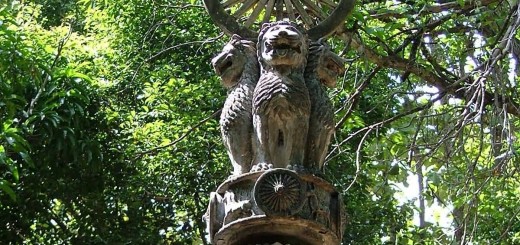One Of The Wonder Of India – The Golden Temple

The Golden Temple (Photo Credit: Marc Hoffmann / CC BY-SA 2.0)
The Harmandir Sahib and informally referred to as the “Golden Temple”, is the holiest Sikh gurdwara located in the city of Amritsar, Punjab, India. The city was founded in 1574 by the fourth Sikh guru, Guru Ram Das. The Harmandir Sahib was designed by the fifth guru, Guru Arjan, who had the cornerstone laid by the Muslim Sufi saint Sai Hazrat Mian Mir on 28 December 1588.
Guru Arjan completed the Adi Granth, the holy scripture of Sikhism, in 1604 and installed it in the gurdwara. There are four doors to get into the Harmandir Sahib, which symbolize the openness of the Sikhs towards all people and religions.The present-day gurdwara was rebuilt in 1764 by Jassa Singh Ahluwalia with the help of other Sikh Misls. In the early nineteenth century, Maharaja Ranjit Singh secured the Punjab region from outside attack and covered the upper floors of the gurdwara with gold, which gives it its distinctive appearance and its English name.
The Harimandir Sahib is considered holy by Sikhs. The holiest text of Sikhism, the Guru Granth Sahib, is always present inside the gurdwara. Its construction was mainly intended to build a place of worship for men and women from all walks of life and all religions to come and worship God equally. Over 100,000 people visit the holy shrine daily for worship.
History:
The Harmandir Sahib literally means the Temple of God. In 1578 CE Guru Ram Das excavated a tank, which subsequently became known as Amritsar giving its name to the city that grew around it.
In due course, the Harmandir Sahib, was built in the middle of this tank and became the supreme centre of Sikhism. Its sanctum came to house the Adi Granth comprising compositions of Sikh Gurus and other saints considered to have Sikh values and philosophies, e.g., Baba Farid, and Kabir. The compilation of the Adi Granth was started by the fifth guru of Sikhism, Guru Arjan.

A Token For The Shoe Storage (Photo Credit: Connie Ma / CC BY-SA 2.0)
Construction:
Guru Arjan conceived the idea of creating a central place of worship for the Sikhs and designed the architecture of Harmandir Sahib. Earlier the planning to excavate the holy tank was chalked out by Guru Amar Das, the Third Sikh Guru, but it was executed by Guru Ram Das under the supervision of Baba Budha. The land for the site was acquired by the earlier Guru Sahibs on payment or free of cost from the Zamindars of native villages. The plan to establish a town settlement was also made and the construction work on the Sarovar (the tank) and the town started simultaneously in 1570. The work on both projects was completed in 1577.
In December 1588, Guru Arjan initiated the construction of the gurdwara and the foundation stone was laid by Hazrat Mian Mir on 28 December 1588. The gurdwara was completed in 1604. Guru Arjan installed the Guru Granth Sahib in it and appointed Baba Buddha as the first Granthi of it on August 1604. In the mid-18th century it was attacked by the Afghans, by one of Ahmed Shah Abdali’s generals, Jahan Khan, and had to be substantially rebuilt in the 1760s. However, in response a Sikh Army was sent to hunt down the Afghan force. The forces met five miles outside Amritsar and Jahan Khan’s army was destroyed.

Waiting For Food (Photo Credit: Connie Ma / CC BY-SA 2.0)
Operation Blue Star:
Blue Star was a military operation undertaken on 3 June 1984 and ended on 6 June 1984. The Indian Army, led by General Kuldip Singh Brar, brought infantry, artillery, and tanks into the Harmandir Sahib to put a stop to Dharam Yudh Morcha led by Jarnail Singh Bhindranwale. During these “Morcha” thousands of Sikhs courted arrest. The then Indian prime minister Indira Gandhi ordered the army to launch the operation. Within six months, Indira Gandhi’s Sikh bodyguards killed her (31 October 1984) for the perceived sacrilege.
Fierce fighting ensued between Sikhs and the soldiers, in which many of the Sikhs were killed along with many soldiers. The Harmandir Sahib complex also suffered much damage due to the attack, especially the holy Akal Takhat Sahib. This attack is regarded by Sikhs as a desecration of Sikhism’s holiest shrine and discrimination against a minority in India. In 1986, the repairs performed on the Akal Takhat Sahib after the attack, which the Rajiv Gandhi government had undertaken without consultation, were removed. A new Akal Takhat Sahib was completed in 1999 by Kar Sevaks
Architectural feature:
Some of the architectural features of the Harmandir Sahib were intended to be symbolic of the Sikh world view. Instead of the normal custom of building a gurdwara on high land, it was built at a lower level than the surrounding land so that devotees would have to go down steps to enter it.
In addition, instead of one entrance, Sri Harmandir Sahib has four entrances. The gurdwara is surrounded by the Sarovar, a large lake or holy tank, which consists of Amrit and is fed by the Ravi River. There are four entrances to the gurdwara, signifying the importance of acceptance and openness. Inside the gurdwara complex there are many shrines to past Sikh Gurus, saints and martyrs.
There are three holy trees, each signifying a historical event or Sikh saint. Inside the gurdwara there are many memorial plaques that commemorate past Sikh historical events, saints, martyrs and includes commemorative inscriptions of all the Sikh soldiers who died fighting in World Wars I and II. The ceiling of Harminder Sahib is made with gold and precious stones. Dukh Bhanjani Beri & Ath Sath Tirath. Much of the present decorative gilding and marblework dates from the early 19th century.
All the gold and exquisite marble work were conducted under the patronage of Hukam Singh Chimni and Emperor Ranjit Singh, Maharaja of the Sikh Empire of the Punjab. The Darshani Deorhi Arch stands at the beginning of the causeway to the Harmandir Sahib; it is 62 m high and 6 m in width. The gold plating on the Harmandir Sahib was begun by Ranjit Singh and was finished in 1830. Maharaja Ranjit Singh was a major donor of wealth and materials for the shrine.

Volunteers Preparing Food (Photo Credit: Connie Ma / CC BY-SA 3.0)















